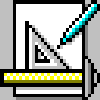


|
|

|
|||
|
|
|
Mechanical dissection is the process of disassembling, inspecting, and reassembling a mechanical device to discover how it works. Familiarity with commonly used mechanisms greatly improves an engineer's ability to solve new design problems, so learning the basics of dissection is an essential part of a mechanical engineering education. Almost any object can be dissected, but it is best to use objects that are basically mechanical in nature (an electric drill is good, but a calculator is not) and have a reasonable number of parts (3 is not enough; 50 is too many). Cost, size, and weight may also be important in choosing what to dissect. Instructors may assign a device, or allow students to select their own. In the case of student selection, make sure that students are choosing appropriate devices. There may be guidelines like a minimum/maximum number of parts, types of parts (i.e., must contain gears, a spring, a motor, etc.), or functional category (power tool, kitchen appliance, toy).
After choosing a device, the instructor must disassemble it and reassemble it several times to determine not only how the machine works, but also what tools are required for dissassembly and what parts of disassembly or reassembly are likely to be the most difficult for students. Students may be provided with fairly extensive guidance (some examples under "Additional Information" below) or may be asked to perform the dissection independently. Likewise, a dissection kit including all the tools required for dissection may be handed out, the students can be given the list but not the tools, or they may be required to determine independently what tools are needed. At the end of the dissection, there should be some hand-in, probably a combination of drawings and text, which shows that the student understands the object, and reassembled items should be inspected to show that they still work. For a more advanced analysis, students can identify the manufacturing process used to produce each part, and estimate the cost.
Instructors must choose and disassemble the objects and prepare dissection guides and kits prior to giving out the assignment. If the dissection is done in class, course staff should be prepared to help students, especially with analysis and reassembly.
This project is appropriate for the following variations (most are described in the section how to make design projects more meaningful):

|
introduction | in class projects | short term projects | long term projects | related sites |

|